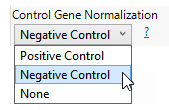Use this option to specify which control gene normalization method to use, Positive Control, Negative Control, or None.
Positive Control normalization, also known as code-count normalization, uses a series of exogenous probes (genes) of known concentration. Observed variation for these genes can be attributed specifically to the assay. Normalization occurs by summarizing (i.e. mean or geometric mean) the positive control counts and adjusting samples by a factor relative to other samples.
In Negative Control normalization, also known as background correction, the background level is calculated as an aggregate summary of six to eight control probes with no target transcript. The calculated background level for each sample is then subtracted from the adjusted probe value.
Choose None when you opt to use non-normalized data.
